- Poetry School
- Posts
- Volume 5, No. 15: The Birds are Back
Volume 5, No. 15: The Birds are Back
winterberry, paleolithic mysteries, thinking slowly, little brown birds
Greetings, poetry people! The end of the semester is nearing and I’m in the middle of so many projects: an essay about Mary Oliver, a research paper on the legacies of Manet’s Olympia, a paper explaining a meme I made with an image from the Lascaux caves, a presentation on anti-Palestinian art censorship…
There is also the world. There is also caring for my pup, and getting my house ready for winter, and groceries and sleeping and sweet voice exchanges with dear ones, and writing a poem every day…
I’m feeling overwhelmed in good ways and hard ways, but I’m still here, sharing my words with you. I wrote these snippets in in-between moments, and I’m glad I made the space for it.

Notes On...
Welcome to the Silly, Comforting Poem
One of the sections in Mary Oliver’s book-length poem The Leaf and the Cloud opens with this line: “Welcome to the silly, comforting poem.” It’s one of my favorite poems, and it is not silly, or especially comforting, but it does remind me just how many registers making takes place in. Poetry can be small, it can be vast, it can be serious, it can be silly.
I wrote this poem last week for my 30 Poems in November! fundraiser, which is still going strong; you can donate here! The prompt was to write a poem with the repeated line, “I have been thinking.” This is where I went with it. It’s not a revelatory poem, but it was a) super fun to write, and b) opened up my thinking around punctuation, trees, and form. Sometimes a poem is not finished or final. Sometimes it’s just a flash that leads you somewhere, a moment of process.
Everything is Trees
I have been thinking—slowly.
I have been thinking, slowly.
I have been thinking slowly!
I have / been thinking / slowly.
Slowly: I’ve been thinking.
I have been thinking. Slowly.
I have been (thinking) slowly.
I have been; thinking slowly.
I have been thinking slowly.
Thank You, Alice Wong
Author, activist, visionary, and disabled oracle Alice Wong died this week. It shook me up. I am thinking of her loved ones, her big community, all the people she organized and created with, all the people she welcomed in. Her work and words have opened so many portals for so many people, including me, and they will go on doing so even though she’s gone. If you haven’t yet read her incredible memoir, Year of the Tiger, I hope you do. I’ve been thinking about these words from Wong, shared by her friend and colleague Sandy Ho:
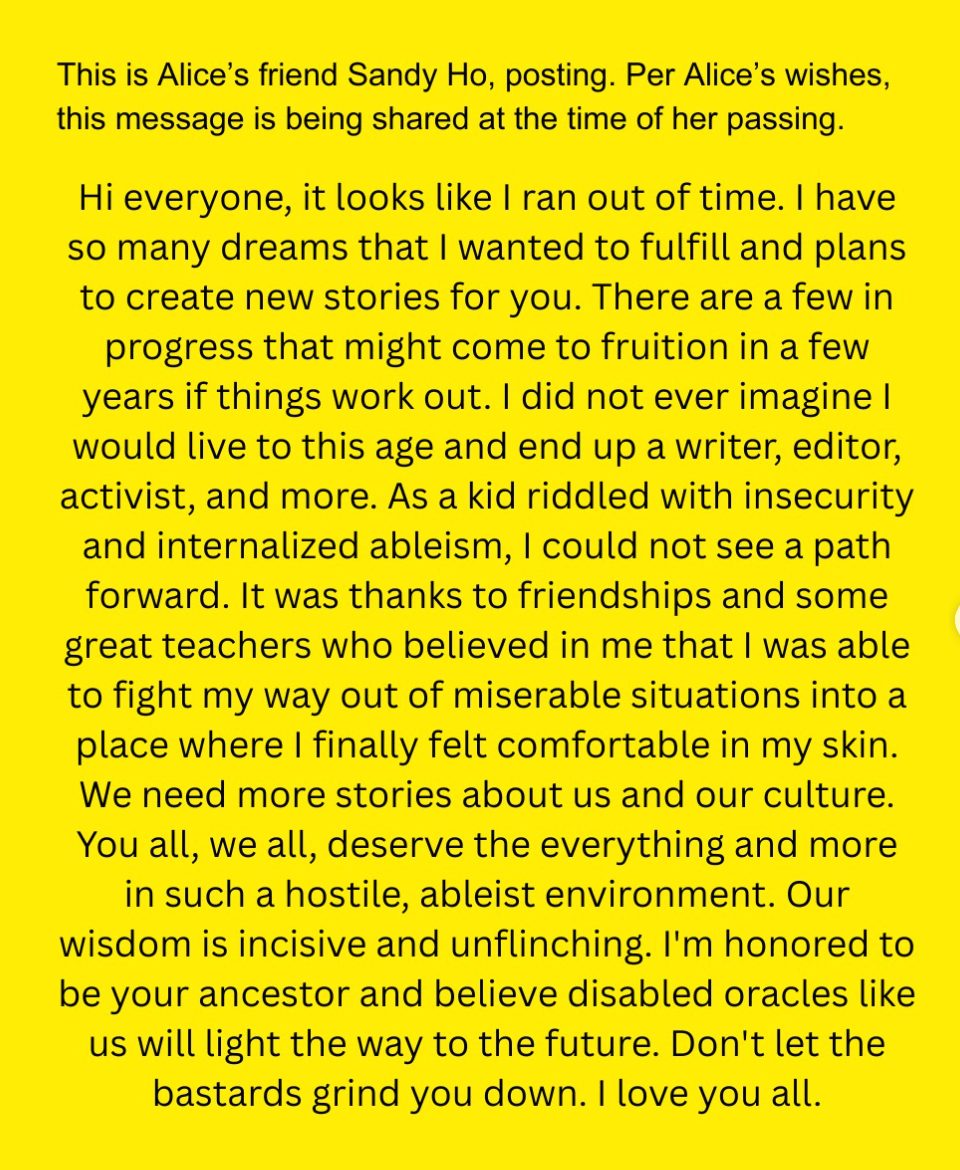
I also love this reminder from Year of the Tiger:
The real gift any person can give is a web of connective tissue. If we love fiercely, our ancestors live among and speak to us through these incandescent filaments glowing from the warmth of memories.
AI Could Never
For my art history survey course, our final assignment is to make a meme using any image from the time the course covers and then write a paper explaining the art historical context of said meme. Here’s what I did:
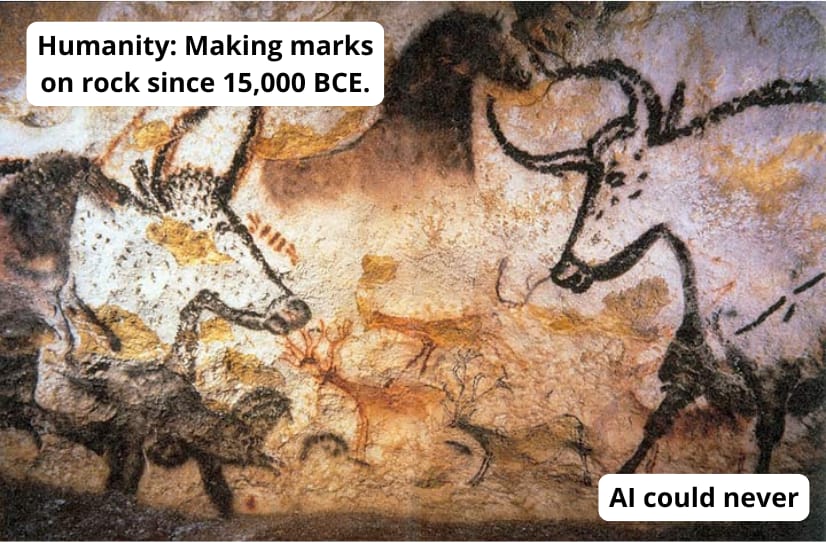
Hall of Bulls, Lascaux, France, 16,000-14,000 BCE
I think this is pretty self-explanatory, but the thing about it that really gets me, and which I’ll write about in my paper, is this: Anything we say about this image is a guess. We don’t actually have any fucking idea what the humans who made these images were trying to say. We can read this image because we are human, too—because we share some innate strangeness with our mysterious ancestors. We feel something, looking at it. But we don’t know. We will never know. AI could never make a painting like this, sure. But more importantly, to me: AI could never feel whatever weird current moves through me, when I look at this. And AI could never figure it out. There is nothing to figure it out.
There is nothing to figure out. Some things live in a place beyond knowledge.
Along the same lines, I’m finding myself somewhat bored with my history of modern art class (I’m surprised, too). I might scream if I have to look at one more piece of art made by one more white European man. (Which means, I will scream.)
However, there is also Helen Frankenthaler:
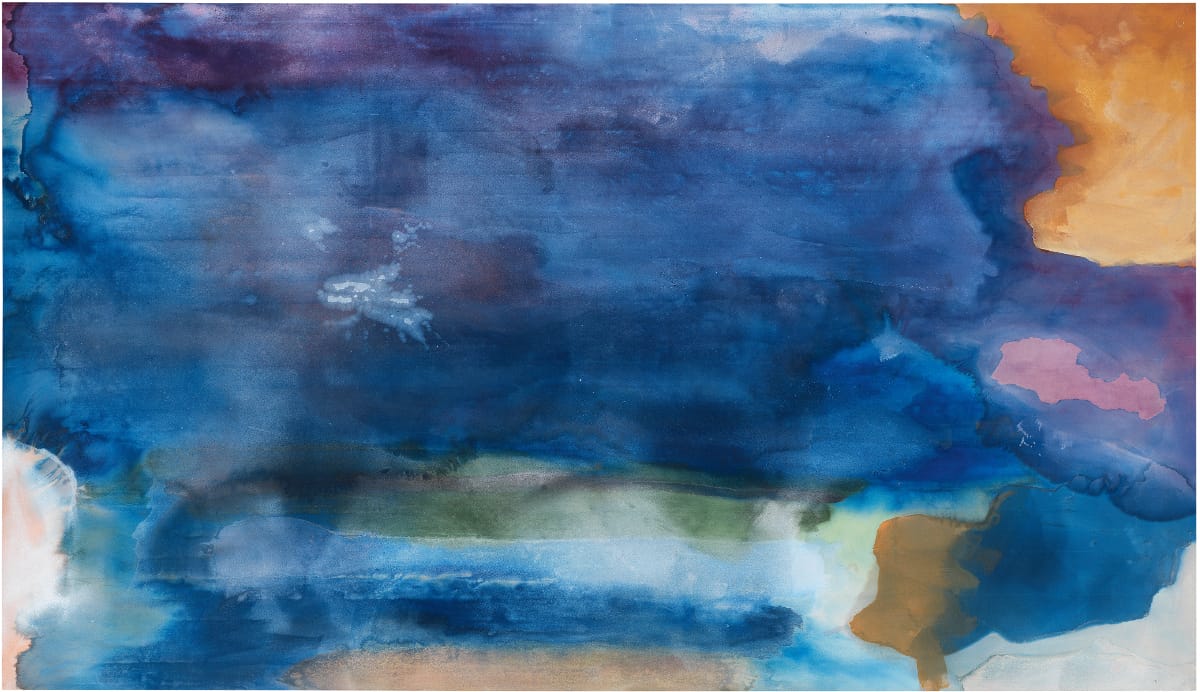
Helen Frankenthaler, Riverhead, 1963, acrylic on canvas. Photo: Rob McKeever, Courtesy Gagosian.
Who are your favorite not at all famous artists? Please come shout about them in the comments!
The Birds are Back, My Heart is Full
On Monday afternoon, I put up my bird feeder again for the winter. Summer isn’t really bird-feeding season. Also, there are the bears. I can’t have a bird feeder at my house in the summer because then I will have bears on my porch, like this visitor, who came one year when I didn’t use up the birdseed fast enough in the spring and still had it out on my porch in June.
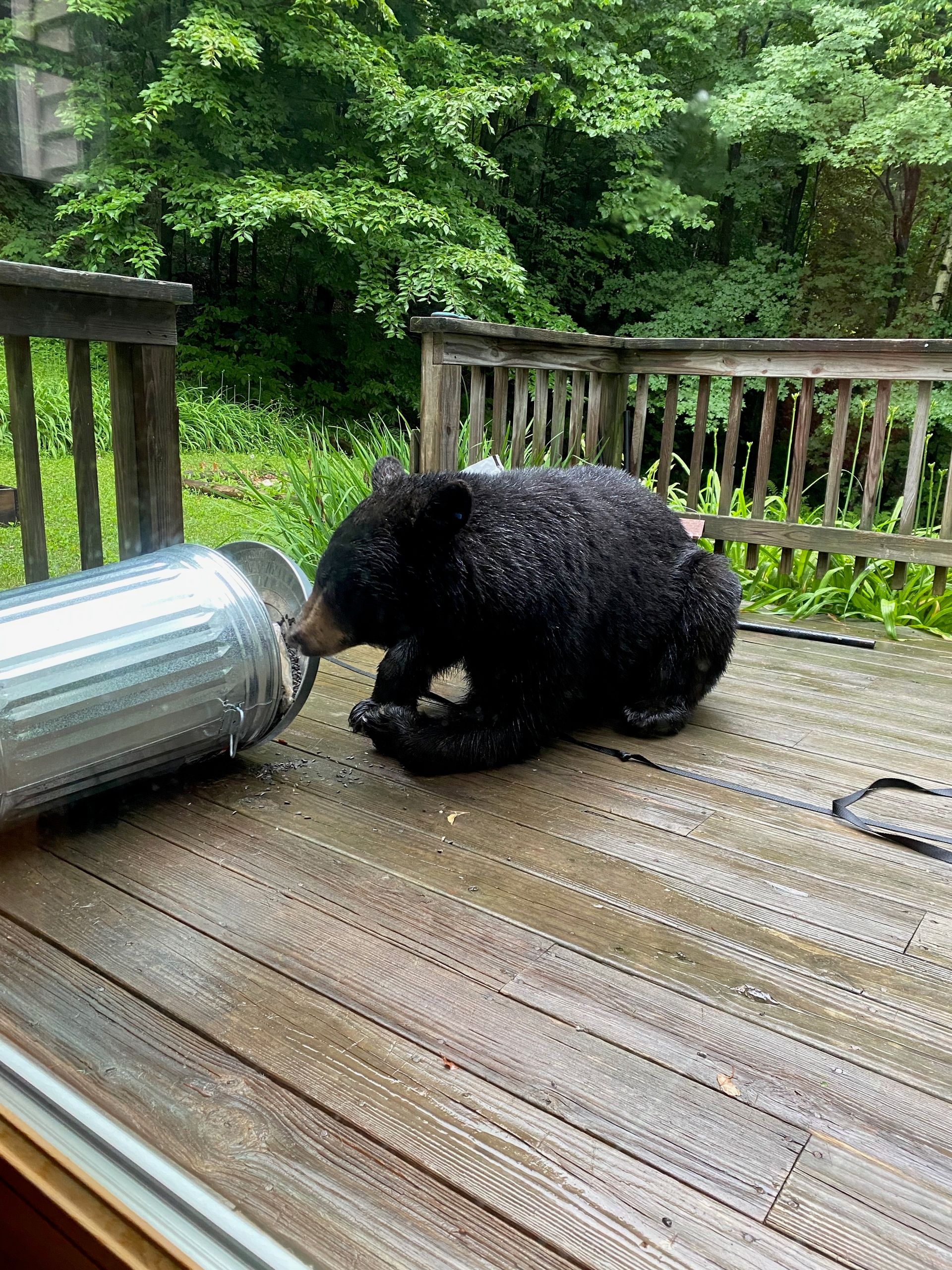
I love bears, but not on my porch.
Putting up the feeder again is one of the ways I welcome winter. I know the bears probably aren’t asleep yet, but I’ve always put up the feeder in late October or early November, and so far I haven’t had any late fall bear visitors.
Sometimes it takes the birds a few days to find the feeder again. This year it took them less than 24 hours. I put it up on Monday afternoon; on Tuesday I woke up to titmice, white-breasted nuthatches, chickadees, downy woodpeckers, and my favorite, the most glorious bird in the northern forest, the rest-bellied woodpecker.
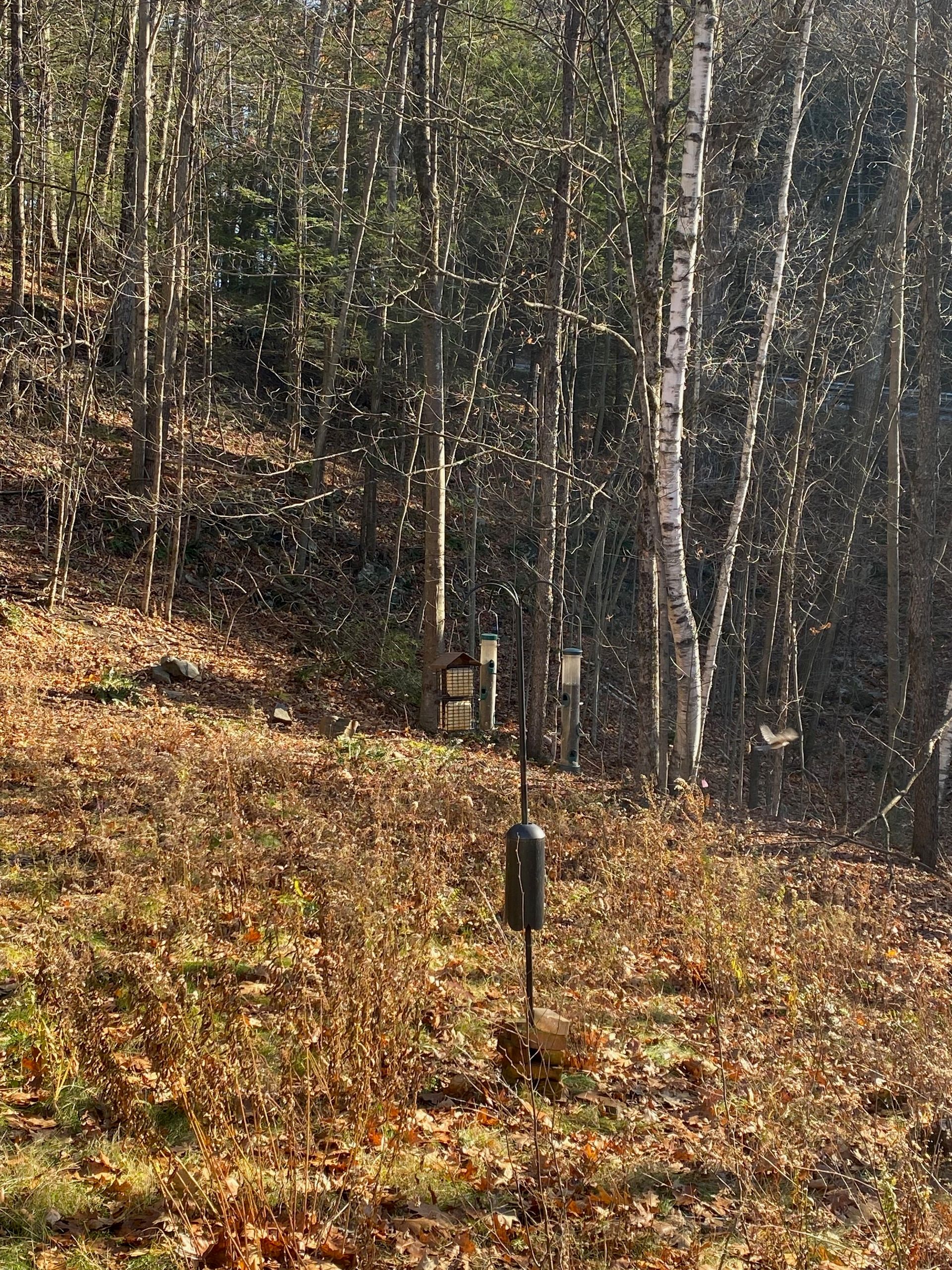
It may not look like much, but this is a factory of winter joy.
I cannot explain how much I missed the birds. I didn’t even realize how much I missed them until I looked out my window on Tuesday and saw the flash of a red-bellied woodpecker’s brilliant crown. I almost started crying. Of course, the birds have been here all along. But I missed watching them: their little dances, the sounds their wings make, the way the downy woodpeckers settle in to pick away at the suet, while the chickadees fly in, grab one seed, and fly out. I love every common bird: the chipping sparrows and the house finches, the dark-eyed juncos with their big beaks, the greedy goldfinches, who eat and eat, the chattering titmice. All winter, they keep me company, living their lives alongside me. I am so happy they are back.
Swapnaa Tamhane: Spaces That Hold
Last weekend a friend and I saw an incredible exhibition at the Mead Museum in Amherst, Swapnaa Tamhane: Spaces That Hold. We were both stunned by it. As we were leaving, I reflected to my friend that looking at art is sometimes really exhausting. What I mean is that, when I’m fully engaged, when I’m fully present with the art, when I allow myself to do all the thinking and feeling that good art asks me to do, when I spend time in an exhibition looking, reading, pondering, being still, processing, and making connections—that takes a lot of work. This exhibition left me exhausted in the best way. It’s open through January 4th—if you’re local, I can’t recommend it enough. The Mead is free!
Earlier in the week I was having a dilemma: I wanted to mention this exhibition, but I was feeling too overwhelmed to write about it. So, instead of synthesizing everything I felt and thought about, I’m going to share some photos of my favorite pieces and the accompanying wall text. I know it’s not the same as being there, but I hope you’ll take some time to sit with this incredible art.
Here’s a little bit about the exhibition itself:
Sorting the world into binaries - black or white, masculine or feminine, Eastern or Western - obscures the rich and varied complexities that exist between them. Swapnaa Tamhane (b. 1976, Toronto, Canada) explores these liminal and often overlooked spaces, blurring the boundaries between art, architecture, craft, and design. Her process is profoundly collaborative, and emphasizes the presence of the hand in drawing, making paper, the treatment of surfaces, and the production of lush, immersive environments. Employing traditional South Asian materials and techniques, she complicates the popular notion that tradition and modernity are opposed to each other, while also laying bare the troubled histories of labor, class, and colonialism that mark the Indian Subcontinent and so many other parts of the world. Tamhane's works challenge visitors to engage deeply and critically with their sublime beauty as well as the historical shadows that haunt them.
I can confirm that I engaged deeply and critically with the sublime beauty and haunting historical shadows of these pieces, although, truly, I could go a lot deeper.
Never Was a Man, 2025

Never Was a Man, 2025. Natural and synthetic dyes on industrially-produced cotton, mirrors on steel dowels.
“Rohith Vemula (1989-2016) was a PhD student at the University of Hyderabad in India who brought to light caste-based discrimination on his campus—a perspective which some viewed as "anti-national." While hospitalized for appendicitis, the president of a student organization with opposing views claimed that Vemula and four other students attacked him.
Though this accusation was never proven, the five students were expelled from university housing and, on January 3, 2016, embarked on a hunger strike in protest. On January 16, Vemula took his own life, blaming his death on the system that marginalized him. This work features two sentences from the letter that Vemula left behind.”

Never Was a Man, 2025
Using wood-block printing on drop cloths—the textiles that are never meant to be seen but that are considered waste material—Vemula's words are endlessly repeated as a beautiful truth that should bind rather than divide us. While I am of a privileged caste, I am quoting two lines of Vemula's letter to consider the suppression that is occurring in educational environments where conversation, debate, and equality should be prescient.
Block printing and dyeing by Salemamad Khatri; block carving by Pragnesh Prajapati
Mobile Palace, 2020-2021
This installation was my favorite piece in the whole exhibition. I spent a long time walking through the hanging textiles, sitting and lying on the benches, and watching the subtle movements of light and breath across the fabric.

Mobile Palace, 2020-2021. Block print on mill-made cotton, beading, appliqué.
“The patterns you see across these panels are drawn from the artist's impressions of the Mill Owners Association Building in Ahmedabad, Gujarat (India)-an iconic structure from the mia-1950s designed by Swiss-French architect Le Corbusier (1887-1965), with renowned Indian architect Balkrishna V. Doshi (1927-2023) serving as site architect. Built in the city where Gandhi began promoting handspun cotton as part of the Indian independence movement, the building was designed for India's leading textile industrialists and stands as a symbol of Western modernism in post-independence India.
Finding little resonance between the building's design and the longstanding emphasis on ornamentation in Indian art and architecture, Tamhane describes the structure as "invasive" and yet is enamoured with it. She reclaims and softens the building, translating views of its interior and exterior into patterns on cotton that are marked by intentional ruptures and interruptions that keep the eyes alert and curious.”
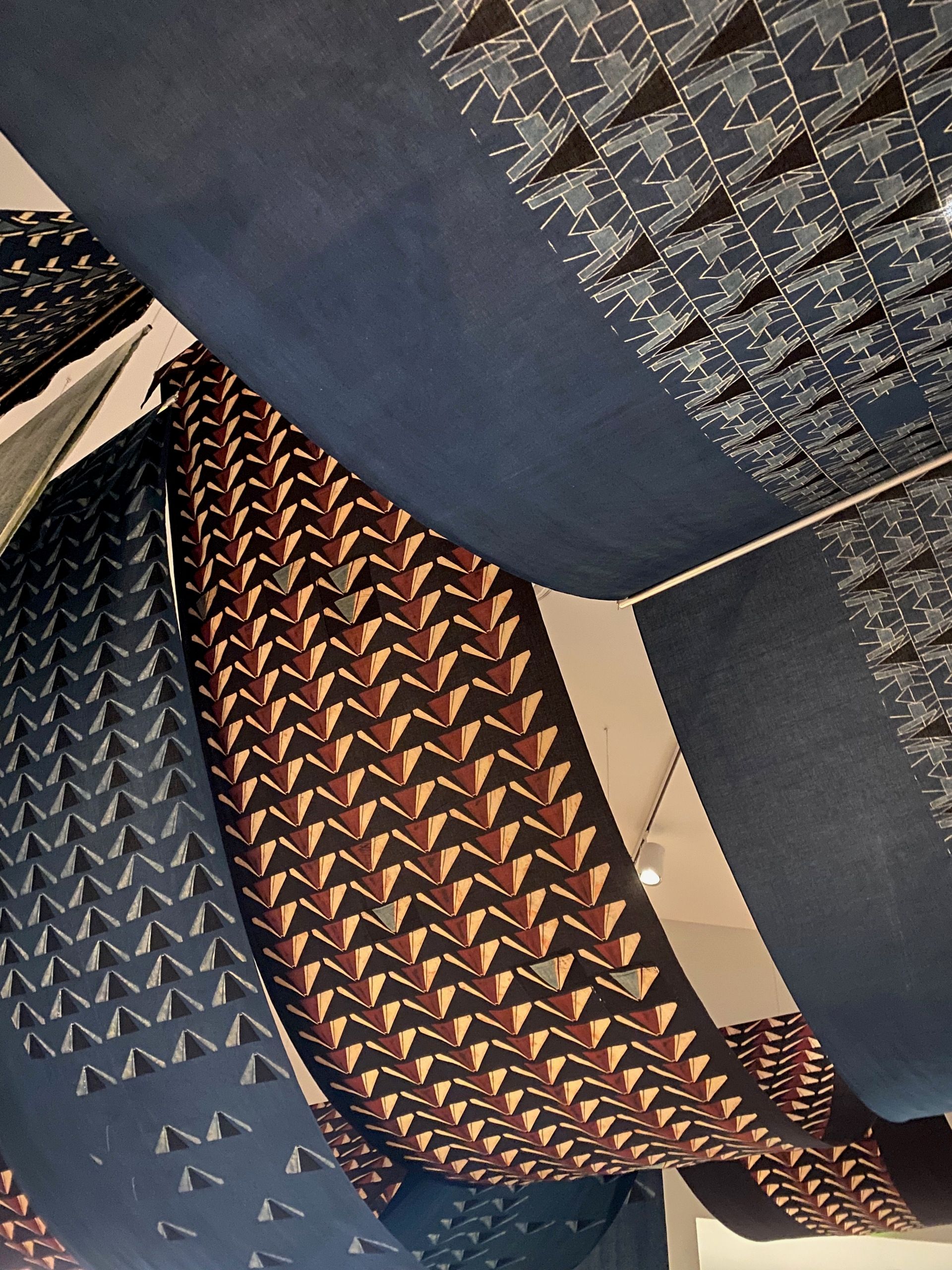
Mobile Palace, 2020-2021, detail.
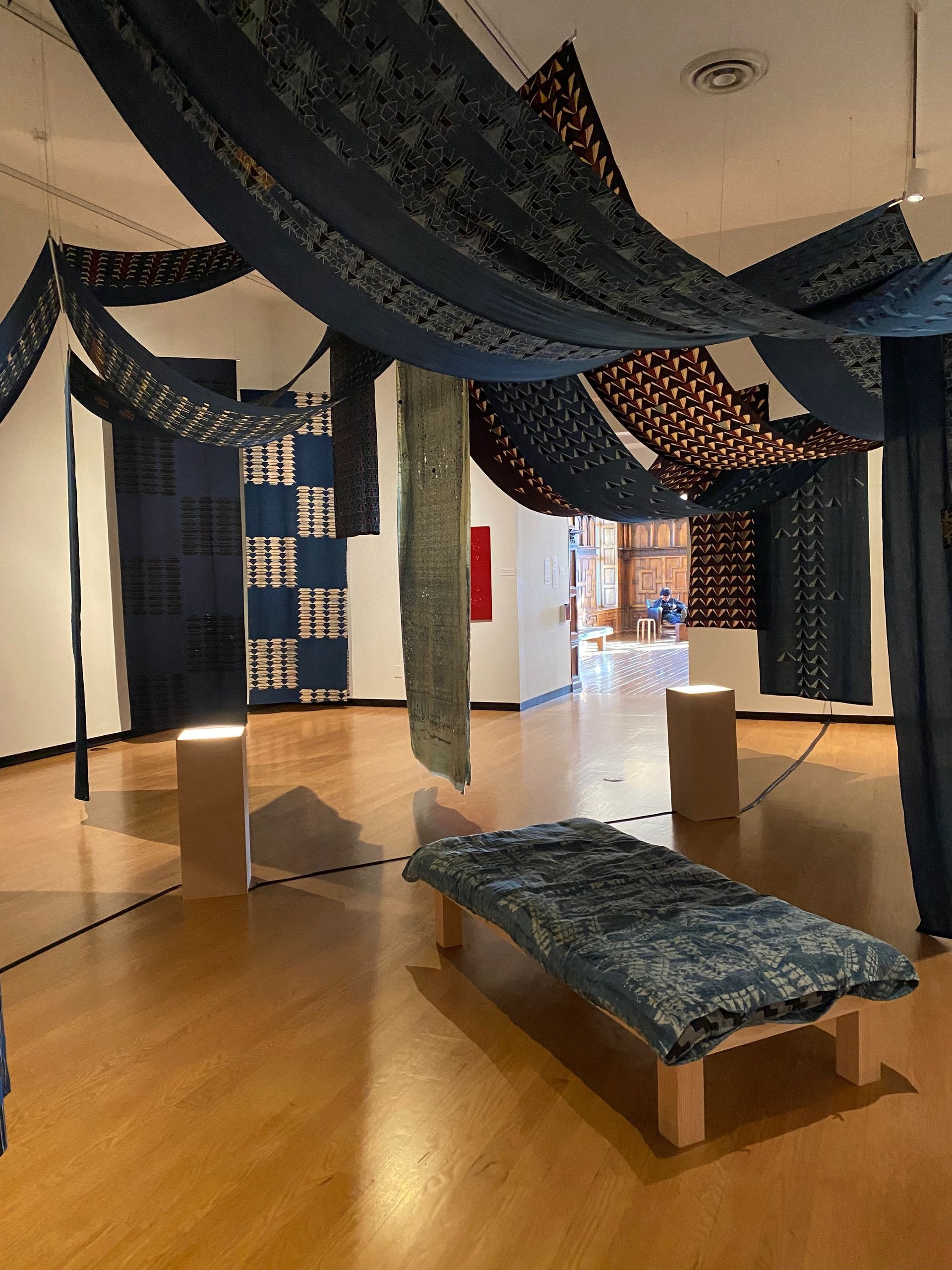
Mobile Palace, 2020-2021.
Made with Salemamad Khatri and Mukesh Prajapati, with assistance from Sine Kundargi-Girard and Lydia Haywood-Munn.
Calendar of Winter Joys: Winterberry
This week’s entry in my calendar of winter joys: winterberry. Winterberry! Ilex verticillata, star of the winter forest! Is there a plant I love more? Maybe, but who cares. Winterberry, dazzling red keeper of my heart. Winterberry, blazing through all the green and brown. Winterberry cascading through the wetlands, banks and banks of red. When I come across it, it feels like I’ve been blessed by the forest. It’s a plant I can’t translate into words. There is no way to describe the experience of seeing winterberry on a clear, cold afternoon in early December, the saturated light, the sharp blue sky, and then, right there there—as if it were ordinary—that wild red, beckoning.
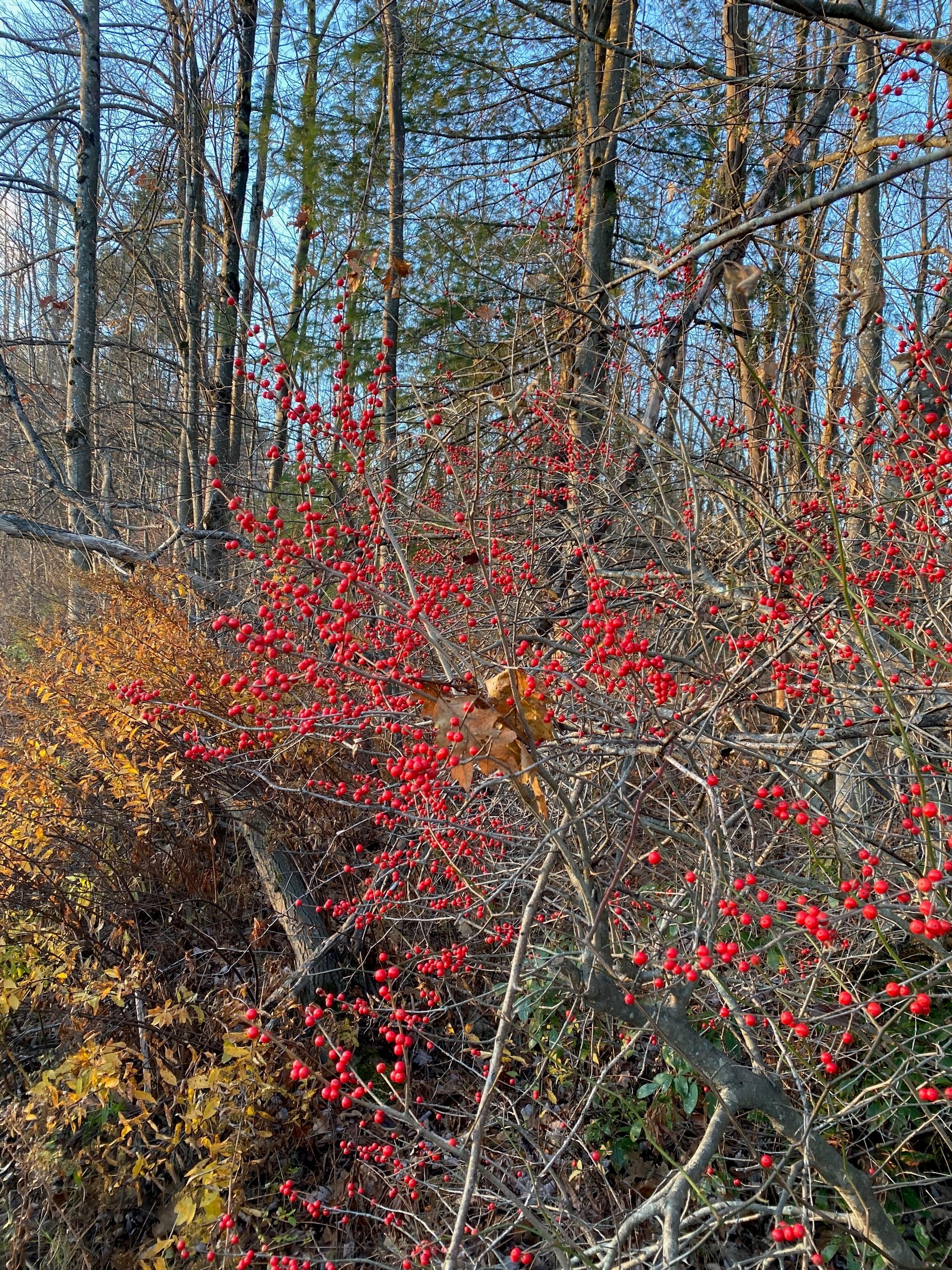
A patch of winterberry on my morning walk.
And Beauty
These winter days, I’m often visiting with my tree at sunset. It’s a gift I will never stop feeling humbled by.
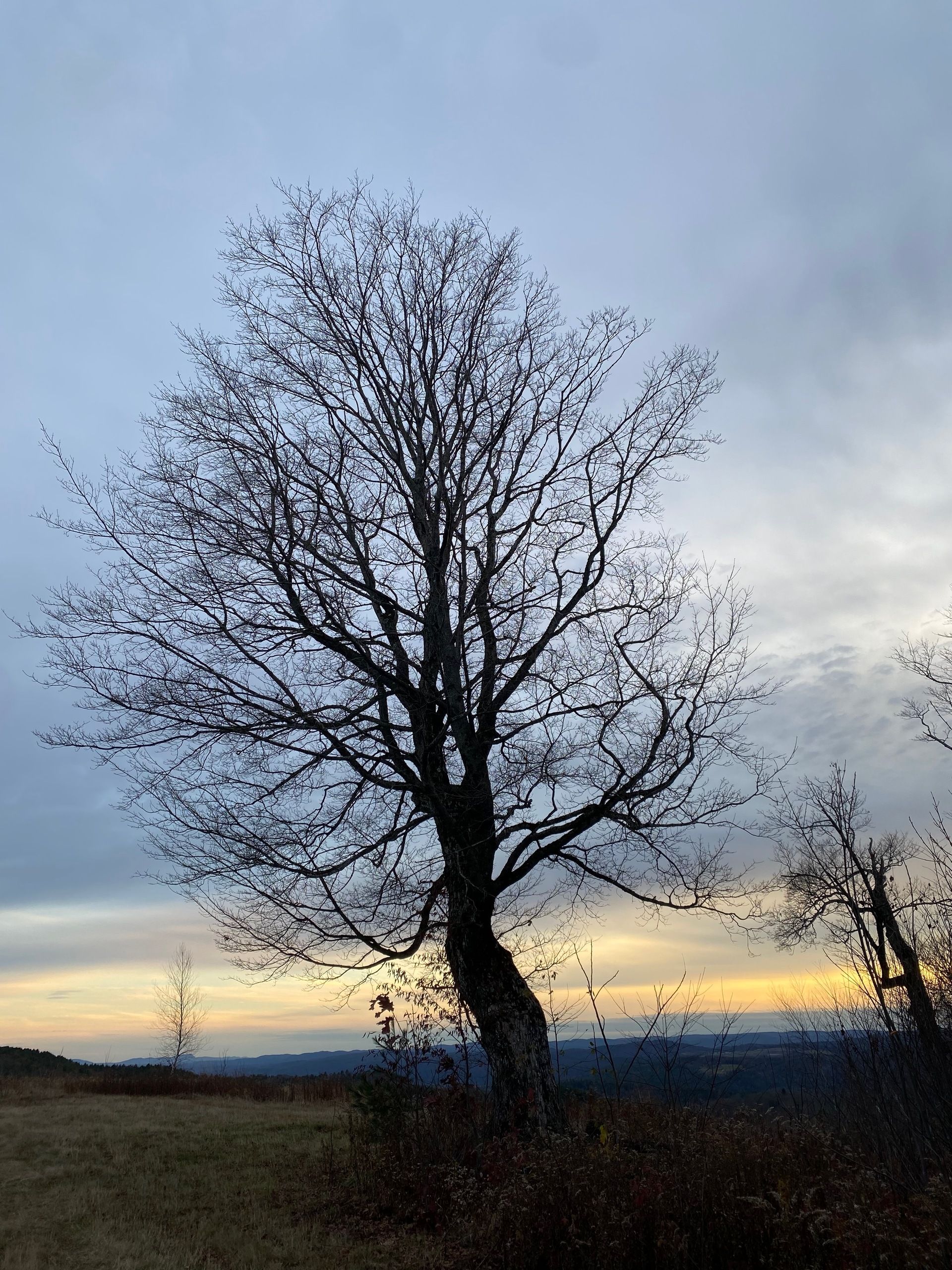
My tree in all its majestic winter glory.
Thanks for reading, friends. Wishing you a smooth and beautiful glide into the heart of the Season of Light.
Reply